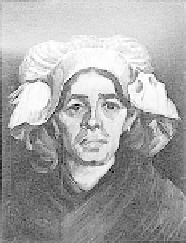Travel Reference
In-Depth Information
Vincent's star-crossed life makes the museum even better, so I've
included doses of biographical material for each painting.
ThE TOuR BEgINs
• Climb the stairs to the first floor. The first room—often displaying self-
portraits—introduces you to the artist.
Vincent van Gogh (1853-1890)
“I am a man of passions...”
—Vincent van Gogh
You could see Vincent van Gogh's canvases as a series of suicide
notes—or as the record of a life full of beauty...too full of beauty.
He attacked life with a passion, experiencing highs and lows
more intensely than the average person. The beauty of the world
overwhelmed him, and its ugliness struck him as only another
dimension of beauty. He tried to absorb all of life, good and bad,
and channel it onto a canvas, and the frustration of this overwhelm-
ing task drove him to madness. If all this is a bit overstated—and I
guess it is—it's an attempt to show the emotional impact that Van
Gogh's works have had on many people, me included.
Vincent, a pastor's son from a small Dutch town, started
working at age 16 as a clerk for an art dealership. But his two inter-
ests, art and religion, distracted him from his dreary work, and
after several years, he was finally fired.
he next 10 years were a collage of dead ends as he traveled
northern Europe pursuing one path after another. He launched
into each project with incredible energy, then became disillusioned
and moved on to something else: teacher at a boarding school,
assistant preacher, bookstore apprentice, preacher again, theol-
ogy student, English student, literature student, art student. He
bounced around England, France, Belgium, and the Netherlands.
He fell in love, but was rejected for someone more respectable. He
quarreled with his family and was estranged. He lived with a pros-
titute and her daughter, offending the few friends he had. Finally,
in his late 20s, worn out, flat broke, and in poor
health, he returned to his family in Nuenen
and made peace. He started to paint.
• For his stark early work, enter the next room.
The Netherlands (1880-1885):
Poverty and Religion
These dark gray canvases show us the hard,
plain existence of the people and town of
Nuenen, in the rural southern Netherlands.
We see simple buildings, bare or autumnal





















